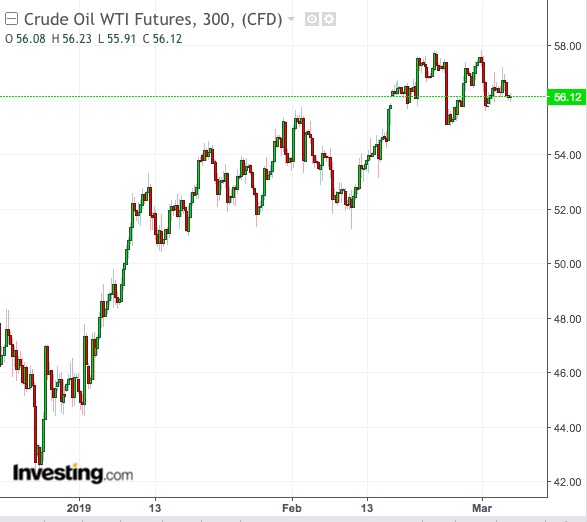From well-timed interviews and speeches hitting the media airwaves to production cuts that are squeezing the market, Saudi Energy Minister Khalid al-Falih has done all he can to give oil its best recovery rally in years. Yet, an unhinged Chinese economy may unravel much of his hard work.
When Falih announced in December the daily supply cut of 1.2 million barrels by the OPEC+ alliance of 25 oil producing countries, he had two main rivals: U.S. shale drillers, who were churning out more barrels of crude than the world needed, and U.S. President Donald Trump, who seemed to care more about pump prices of gasoline with his tweets than the bottomline of U.S. energy companies or foreign national petroleum corporations and their economies.

Thus far, the Saudi Energy Minister has managed to contain both adversaries and preserve this year’s 25% rally in oil.
Falih’s refrain that overproduction ultimately hurts their own industry convinced some shale drillers to exercise restraint that prevented U.S. crude from reaching even higher records of output.
His polite but forceful response to Trump that OPEC will not do the president’s bidding to raise output again, like it did in the summer of 2018, told the market that the oil-producers' cartel was in control of supply-demand this time.
An Unexpected 'Adversary' for OPEC: China
But what Falih may not have bargained for is a third adversary: the sputtering Chinese economy and its continued troubles in reaching trade peace with the U.S.
Lingering differences between the world’s two biggest economies is weighing not just on crude but on almost every risk asset, leaving Riyadh and the combined might of OPEC+ with little cognition on what needs to be done to move the needle further on the oil rally—other than rely perhaps on even deeper production cuts.
New York-based research company Energy Intelligence summed the situation up precisely in its latest note this week when it said:
“OPEC must contend with significant factors outside its control that could disrupt its best-laid plans.”
With more than 60 years of oil market management on its side, OPEC is capable of creating a tight market, the agency said, bringing a contango in U.S. crude and U.K. Brent back into backwardation—by ensuring production cuts drained supplies from millions of barrels stored both onshore and on floating vessels across the world.
Contango is a commodities market dynamic where the spot month contract trades at a discount to its next nearest month, creating losses for an investor switching from spot to futures with nearby month maturities. Backwardation, the opposite of contango, creates a positive yield in such rollovers.
Energy Intelligence also noted that oil’s daily performance is now often dictated by equity markets,
“which in turn are broadly taking cues from perceptions about the progress of trade talks between the U.S. and China.”
It added:
“On the flip side, a sudden and pronounced deterioration of the global macroeconomic picture could leave the market awash with supply and risk another buildup of excess inventories.”
Worries of a global macroeconomic deterioration led by China—rather than fear that OPEC might slash more oil than necessary from the market—is precisely what’s keeping U.S. crude from reaching its next target of $60 per barrel and Brent the expected $70 mark.
2% China Economic Growth In The Long Run?
While Beijing plans stimulus to get its economy moving again later this year, the gross domestic product growth of 6% to 6.5% it has forecast in 2019 would be its lowest in nearly three decades. Worse, GDP growth could plummet to 2% over the next decade—truly ending China’s reign as a global economic outperformer, said research consultancy Capital Economics’ Chief Asia Economist Mark Williams.
Those long on oil say the China-related fears were overblown. Phil Flynn, senior energy analyst at brokerage firm The Price Futures Group in Chicago, said:
"The doom and gloom the bears have priced in has far exceeded the reality of a slowdown in China and underestimates China’s commitment to cut taxes and do what it can to keep the Chinese’s people working."
For now, it appears like OPEC+’s strategy is to slash itself out of any market slowdown, with the Saudis particularly, cutting more supply than committed under the December agreement and exhorting others in the alliance, especially Russia, to do the same. Goldman Sachs said in a note this week the producer group should have a sterling report card to gloat over when it reconvenes in April to review its compliance with the cuts.
New Supply Woes From Shale Looming Over OPEC
Yet, despite their discipline in draining the market, Falih and the other OPEC+ oil ministers are facing new challenges from supermajors such as Chevron (NYSE:CVX) and Exxon Mobil (NYSE:XOM), which on Tuesday announced plans to churn out close to 1 million barrels of shale oil each per day in the Permian Basin, one of the most prolific oil basins in the U.S.
Such forecasts raise questions on how much more the Saudis might have to cut in the future to balance the market when demand falls short of expectations.
Adding to the cloud hanging over the market, the American Petroleum Institute reported late on Monday that U.S. crude inventories rose by 7.3 million barrels last week, significantly higher than the 1.2 million expected by the market.
If true, that would almost neuter the positive impact of the near 9 million barrels drawn down in the previous week. The U.S. Energy Information Administration will report later on Tuesday official supply-demand data for last week.
